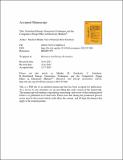Files in this item
Distributed energy generation techniques and the competitive fringe effect in electricity markets
Item metadata
| dc.contributor.author | Mulder, Machiel | |
| dc.contributor.author | Petrikaitė, Vaiva | |
| dc.contributor.author | Scholtens, Bert | |
| dc.date.accessioned | 2017-07-26T23:32:47Z | |
| dc.date.available | 2017-07-26T23:32:47Z | |
| dc.date.issued | 2015 | |
| dc.identifier | 207520277 | |
| dc.identifier | 993a3656-6a08-4f6a-9a97-b5ce619faa64 | |
| dc.identifier | 84940191844 | |
| dc.identifier | 000365049900008 | |
| dc.identifier.citation | Mulder , M , Petrikaitė , V & Scholtens , B 2015 , ' Distributed energy generation techniques and the competitive fringe effect in electricity markets ' , Resource and Energy Economics , vol. In press . https://doi.org/10.1016/j.reseneeco.2015.07.004 | en |
| dc.identifier.issn | 0928-7655 | |
| dc.identifier.other | RIS: urn:E8B192AE4C0A2BDFE076D8F5DCAF42ED | |
| dc.identifier.other | ORCID: /0000-0001-5774-5191/work/27162430 | |
| dc.identifier.uri | https://hdl.handle.net/10023/11299 | |
| dc.description.abstract | We analyse the impact of two different generation techniques used by fringe suppliers on the intensity of competition in the electricity wholesale market. For that purpose we derive a Cournot model of this market taking into account long-term contracts, international trade and fringe suppliers using different energy generating technologies. We apply this model to the Dutch market and estimate the impact of fringe supply on the Lerner index. We find that the fringe supply coming from both intermittent wind generation and combined heat and power (CHP) plants operated by horticultural farmers increases competition, which leads to lower prices in the electricity market. However, this impact is relatively small. The effect per unit of intermittent wind electricity generation on competition and, therefore, prices is stronger than that of the CHP technology. | |
| dc.format.extent | 877198 | |
| dc.language.iso | eng | |
| dc.relation.ispartof | Resource and Energy Economics | en |
| dc.subject | Green technology | en |
| dc.subject | Quantity competition | en |
| dc.subject | Fringe effect | en |
| dc.subject | CHP | en |
| dc.subject | Wind energy | en |
| dc.subject | HB Economic Theory | en |
| dc.subject.lcc | HB | en |
| dc.title | Distributed energy generation techniques and the competitive fringe effect in electricity markets | en |
| dc.type | Journal article | en |
| dc.contributor.institution | University of St Andrews. School of Management | en |
| dc.contributor.institution | University of St Andrews. Centre for Responsible Banking and Finance | en |
| dc.identifier.doi | 10.1016/j.reseneeco.2015.07.004 | |
| dc.description.status | Peer reviewed | en |
| dc.date.embargoedUntil | 2017-07-26 |
This item appears in the following Collection(s)
Items in the St Andrews Research Repository are protected by copyright, with all rights reserved, unless otherwise indicated.

